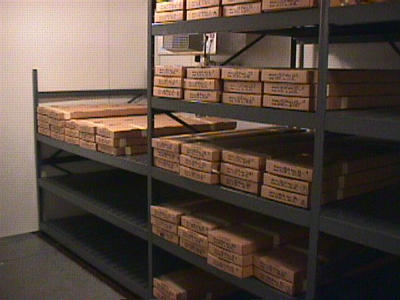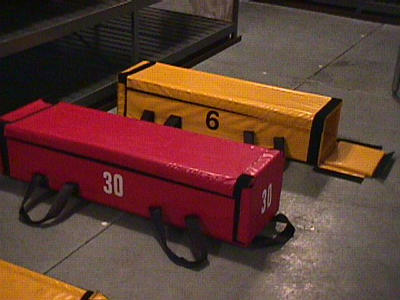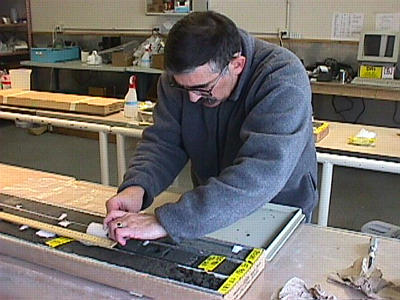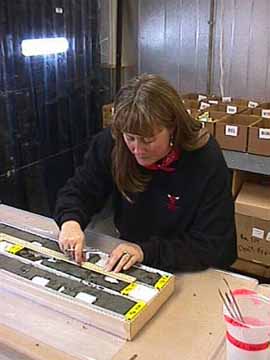10 November, 1998
Tuesday, November 10, 1998
Hello to family, students, and friends. Six new boxes of core were available
in the sampling lab today. It is a steady stream now, and our paleomag team
has plenty to do. While Gary, Ken, and Leo decided which places to drill our
samples, I stayed back in our lab and worked on my laptop computer. I
carefully went through ALL of my floppy disks from my digital camera and re-
labeled every single photo that I've taken since leaving Crystal Lake. This
makes it easier to send the photos to YOU as a slide show and at the end of my
journals. This was no small task…I have used 14 disks…with about 27 photos on
each one. How many disks is that in all?
Look for these photos on my "page" in the Glacier site. I am not sure if they
will stay in the order that I send them…but I am writing a brief caption for
most of them. I want to keep them in chronological order (order in which the
events happened), but who knows how it will end up. Just enjoy the photos!
This afternoon Fabio and I did the drilling, while Ken and Gary prepared the
core for us to drill and put it away when we were finished. You can REALLY
tell the difference in the type of sediments we are seeing now. The drilling
only took one and a half hours…much less time than usual. This was due to the
fact that all of the samples we drilled stayed in tact, and the drill bit
didn't get clogged with the sample. Most of the samples we drilled today
ended up being perfectly rounded cylinders. Now they need to be trimmed up
and dried overnight, and then we can measure them tomorrow.
Later this evening, I helped Ken and Gary take some samples out of earlier
boxes. These samples were taken in the small clear boxes that I talked about
before…like the magnifying boxes sometimes used by naturalists (called bug
boxes). We used these boxes because the sediments are so sandy and fine that
they wouldn't hold together…especially if we used the spinner magnetometer.
Gary and Ken decided where to place the boxes, then dug neatly around the
outside of the box and pressed it "empty side INTO" the core. The box filled
up with sediments and was later removed and a cap was placed on top to hold
the sediments in. I went along scratching the numbers on each tiny box.
Remember, we write down the exact spot on the core where our samples are
taken. The numbers I used were ones like 38.67…I rounded off to two decimal
places.
When this task was finished, Tom (one of the curators), Ken, Gary, and I
carried the boxes of core back to the storage building where they will be kept
until shipment back to the United States and Germany. The boxes are stacked
three at a time inside of a padded carrying case with four handles. It takes
two people to carry each case outside of Crary Lab and into the storage
building nearby. I have some pictures of some of these events that will give
you a better idea of what's going on.
I forgot to tell you that yesterday I got my helicopter (referred to as a
Helo) training up at the Search and Rescue building. We had to watch a video
on helicopters and safety in Antarctica, review what's in the survival bags
that are brought on board each helicopter flight in Antarctica, and practice
putting on the seat belt (they had a practice seat in the building). We
didn't actually go near a helicopter, but I hope that will happen to me very
soon. I'm anxious to see other parts of the continent.
I am thinking of all of you, and hope that you are safe and WARM! Have a nice
day wherever you are and I'll talk to you tomorrow.
Betty :)

This small building is near Crary Lab. The boxes of cores, both working and archive halves, are stored here until they are shipped to the United States or Germany .

Each one of these carrying cases can hold three boxes of core samples. It takes two people to carry each case...using the handles on each side. The carrying cases are quite heavy when loaded with three boxes of core! Just ask me...I have had to carry them from the core sampling room to the other small building two nights in a row.

Ken was putting the sections of core back together after Fabio and I finished drilling each sample.

I had to be very exact when I measured the spot where the sample was taken. I etched the number on the bottom of each small plastic box. These samples wil l be mea sured at a later date, using a machine Ken has back in his lab in Davis, California.
Contact the TEA in the field at
.
If you cannot connect through your browser, copy the
TEA's e-mail address in the "To:" line of
your favorite e-mail package.
|
